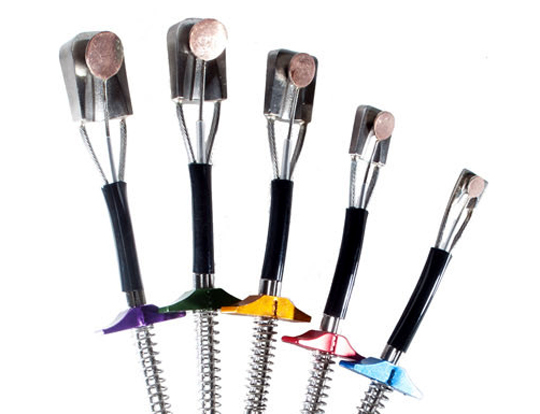MSRP: $39.95
High on El Cap a few years ago, I found myself 30 feet runout with ledge-fall potential breathing up my neck. A small fissure too small for any micro cam yet too parallel for any stopper split open the granite in front of my face. Placements like this made me wish I’d brought a set of slider nuts, though the need I had for that specialized protection is a rare moment in my life as a climber.
In 1987, building off of stacked nut designs and modifications by Charlie Porter, Steve Byrne (who patented his design as “Lowe Balls”), Don Best, a designer at Metolius and his own early drawings, John Middendorf invented devices called Monkey Paws that were made up of two wedges and a ball. He hoped the self-adjusting chocks would serve as functional, active protection for minuscule and flaring cracks in lieu of pounding pitons.
Trango’s modern incarnation they call the BallNutz have the same wedge-and-ball combination and, according to Trango, protect small parallel-sided cracks “better than any other piece of protection available.” When the trigger of the device is pulled, the ball tracks down a milled groove in the aluminum wedge. When the trigger is released, the ball slides back up, applying outward pressure to the inside of the crack and securing it in place.
Their primary function is as clean, removable gear that reduces the quantity of pitons necessary on a climb. They can also supposedly be placed in shallow, bottoming or slightly flaring cracks where other camming protection won’t work. They have a higher strength rating than their cam or nut counterparts in smaller sizes.

There aren’t too many places with a higher concentration of cracks of all shapes and sizes used by such a high volume of free and aid climbers than in Yosemite Valley, where all manner of climbing hardware has been birthed. But I have rarely in my life found a crack so continuously small and thin that it will allow for no other clean gear than BallNutz.
I took a set of them up on the Prow of Washington’s Column and often found myself trying too hard to choose them over the same gear that I use on every big wall. When I did find a placement, it was in the smallest cracks, where they felt secure when placed correctly as points of aid and as free protection. After taking a single fall, bounce testing or holding just body weight, the pieces could be difficult to clean. The sliding ball unit sits so securely against the rock and the aluminum wedge that it sometimes takes a decent amount of force to remove from a crack. While aiding, it is even necessary to use a Funkness Device to clean. In badly scarred rock on popular routes such as the Prow, offset cams work more effectively because of the extremely flaring nature of the placements. If anywhere, BallNutz may find their niche in those thin, laser-split cracks of desert sandstone.

The least useful BallNutz sizes were the largest, which could be bested by cams in nearly every situation, and the placement of smaller sizes needs pretty specific circumstances. I can’t currently justify keeping them on my rack, even while aid climbing. Offset cams, nuts and hooks have worked perfectly fine for nearly every route I have climbed. And despite their superior strength, I am still searching for the opportunity for when I actually need my set of BallNutz.
Pros: Stronger than similar cam sizes; replace the use of knifeblade and lost arrow pitons.
Cons: Copper-coated ball so soft it deforms easily; repeated use of aid damages wires and decreases functionality; higher probability of protection failure when placed in soft rock; hard to clean.